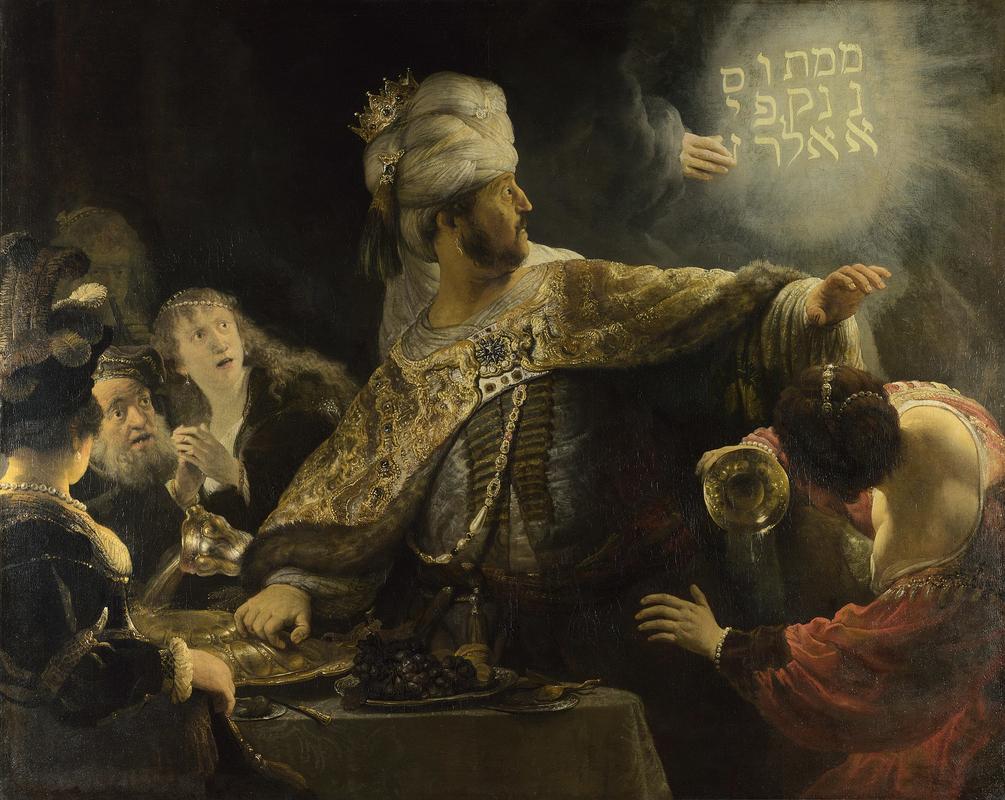More about Belshazzar's Feast

Contributor
If you had to name a painting with the intrigue of a Peter Paul Rubens, the facial expressions of a Caravaggio, and the pathos of a Gentileschi, Belshazzar’s Feast might come to mind.
Rembrandt created this work to expand his portfolio, intending to break into the market for Baroque history tableaus. His efforts paid off; each figure contributes to the scene’s air of foreboding and shock. The fear palpable on each face is justified. Belshazzar’s Feast is based on an Old Testament tale that’s far from idyllic.
In the Book of Daniel, Regent Belshazzar of Babylon served one thousand nobles at a great feast. Perhaps swayed by the merrymaking and encouraged by the wine (haven’t we all engaged in questionable drunk shenanigans?), Belshazzar sent for an assortment of vessels for his guests. His relative Nebuchadnezzar II, a former King of Babylon, had stolen these very treasures from the Temple at Jerusalem. Belshazzar’s grievous offense--drinking from the sacred vessels and serving them to his family and concubines--drew the wrath of God upon him. According to the Old Testament, a hand wrote the menacing words “MENE, MENE, TEKEL, UPHARSIN” on the wall. The words foretold the fall of the kingdom, and Belshazzar was killed before sunrise.
Belshazzar’s predecessor Nebuchadnezzar II had met a far kinder fate. The successful ruler united the Medes and Babylonians through a political marriage and took back the city of Babylon from Assyria. He began an ambitious reconstruction of the capital, supposedly building the legendary Hanging Gardens of Babylon in honor of his wife. Nebuchadnezzar was not one for modesty; the thick walls that surrounded Babylon were inlaid with bricks that glorified his title with the proud script “I am Nebuchadnezzar, King of Babylon.”
Nearly three millennia in the future, Saddam Hussein would attempt to immortalize himself the same way, with walls proclaiming him “President of Iraq, God preserve him, who rebuilt Babylon.” Rembrandt’s tableau and Hussein’s blatant self-aggrandizement are testament to history’s fascination with Belshazzar and Nebuchadnezzar, an interest that will certainly survive for many millennia to come.
Sources
- “Belshazzar’s Feast.” National Gallery. 2018. Accessed September 30, 2018. https://www.nationalgallery.org.uk/paintings/rembrandt-belshazzars-feast.
- Jehl, Douglas. “Look Who's Stealing Nebuchadnezzar's Thunder.” The New York Times. June 2, 1997. Accessed September 30, 2018. https://www.nytimes.com/1997/06/02/world/look-who-s-stealing-nebuchadne….
- Jones, Jonathan. “Belshazzar's Feast, Rembrandt (c1635).” The Guardian. December 26, 2003. Accessed September 30, 2018, https://www.theguardian.com/culture/2003/dec/27/art.
- Mark, Joshua J. “Nebuchadnezzar II.” Ancient History Encyclopedia. July 20, 2010. Accessed September 30, 2018. https://www.ancient.eu/Nebuchadnezzar_II/.
Featured Content
Here is what Wikipedia says about Belshazzar's Feast (Rembrandt)
Belshazzar's Feast is a major painting by Rembrandt now in the National Gallery, London. The painting is Rembrandt's attempt to establish himself as a painter of large, baroque history paintings. The date of the painting is unknown, but most sources give a date between 1635 and 1638.
Check out the full Wikipedia article about Belshazzar's Feast (Rembrandt)












